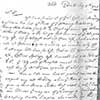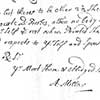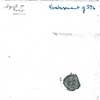Footnote 1
2d Curt, the second day of the current month.
×Footnote 2
Joan Blaeu’s Atlas Scotia (1654).
×Footnote 3
This book, A discourse concerning the operations of the Holy Spirit by William Clagett (1680) was a reply to a controversial theological tract by John Owen, Pneumatologia: or, A discourse concerning the Holy Spirit (1674). Wodrow’s interest in these reflects his ongoing concern with the history of current debates on church policy and politics; that McEuen could source them reflects his participation in a network of booksellers in London.
×Footnote 4
Degory Wheare, Reflectiones hyemales, de ratione & methodo legendi utrasq[ue] historias, civiles & ecclesiasticas (Oxford: W. Hall, 1662).
×Footnote 5
John Strype, The life and acts of the Most Reverend Father in God, John Whitgift, D.D. the third and last Lord Archbishop of Canterbury, in the reign of Queen Elizabeth (London: T. Horne et al., 1718).
×Footnote 6
Arabian nights entertainments: consisting of one thousand and one stories (London: Andrew Bell, 1715), vols 5–6. This series has a complex publication history; various multivolume sets of up to 8 vols, in different formats, were printed before these two vols appeared together in 1715.
×Footnote 7
Thomas Brett, An Account of Church Government, 2nd edn (London: John Wyat, 1710). Brett was highly unusual, being a nonjuring Jacobite bishop who retained a church living under the Archbishop of Canterbury, himself appointed by the Hanoverians.
×Footnote 8
Nathaniel Collier, An Apology for the Clergy of the Church of England (London: R. Knaplock, 1721). This articulate but ephemeral tract, dedicated to the Prince of Wales, was among many that sought to defend the Episcopalian clergy against accusations of presumably Catholic tendencies, including disloyalty to the government, preoccupation with financial matters, and dominance over the moral consciences of their parishioners.
×Footnote 9
Gilbert Burnet (1643–1715), Scottish-born Bishop of Salisbury and a prolific historian. His History of the Reformation of the Church of England in 3 vols (1715), otherwise known as the fourth edition, was an influential reply to Catholic accusations that the Anglican church was merely an example of Henry VIII’s corrupt opportunism. Burnet argued that “what seemed a political act of state was in fact the unfolding of God’s will”.
×Footnote 10
Thursday, 10 August, see note 11.
×Footnote 11
On 29 July, the highest court in Scotland, the Lords of Session (with the exception of two Squadrone supporters, Lord Justice Clerk Cockburn and Lord Tweedale) issued a sederunt (order) requiring the brewers to resume brewing until 1 November, when their complaints would be considered. Rather than attend the court as required on 30 July, Lord Dundas (also a Squadrone supporter) prepared The Petition of the several Brewars in and about Edinburgh under subscribing (Edinburgh: n.p., 1725), signed by 65 of them, explaining their refusal to comply. The Lords, responding to the Town Council (dominated by Argathelians) ordered the Petition burned by the town hangman. On 31 July the Lord Advocate, Duncan Forbes, decided to delay proceedings for ten days (to Thursday 10 August), when the brewers would reappear before the court.
×Footnote 12
Wodrow understood this to mean that only one brewer, Simpson, agreed to sell his ale as demanded by the Lords of Session, but his usual customers refused it. Simpson was an Edinburgh magistrate on the Town Council, which means he probably had little choice but to comply with the order, or forfeit his place as a magistrate.
×Footnote 13
Some 130 brewers who were named in the court documents.
×Footnote 14
John Reynolds (1667–1727), English Presbyterian minister; Death’s vision represented in a philosophical, sacred poem (1709) was reprinted three times before it was published under Reynolds’ name, in 1716.
×Footnote 15
This was probably A Letter from a Fyfe Gentleman, at present in Edinburgh, to the Chief Magistrate of a Burgh in Fyfe, Upon the present Situation, with regard to the Malt-Tax: By the Author of a former Letter from Fyfe upon the same Subject, dated 31 December, 1724. Millar’s uncertainty over whether the material he sent comprises a “pamphlet” may suggest that A Letter was meant to be supplemented by further pamphlets by the same author.
×



